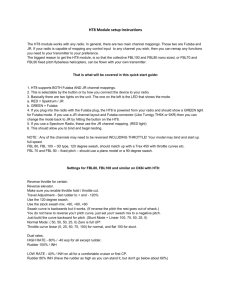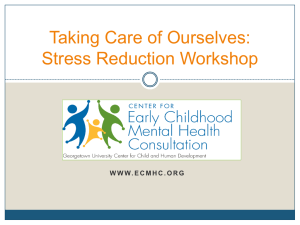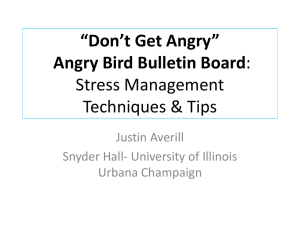Finding Your Optimal Breath per Minute Rate
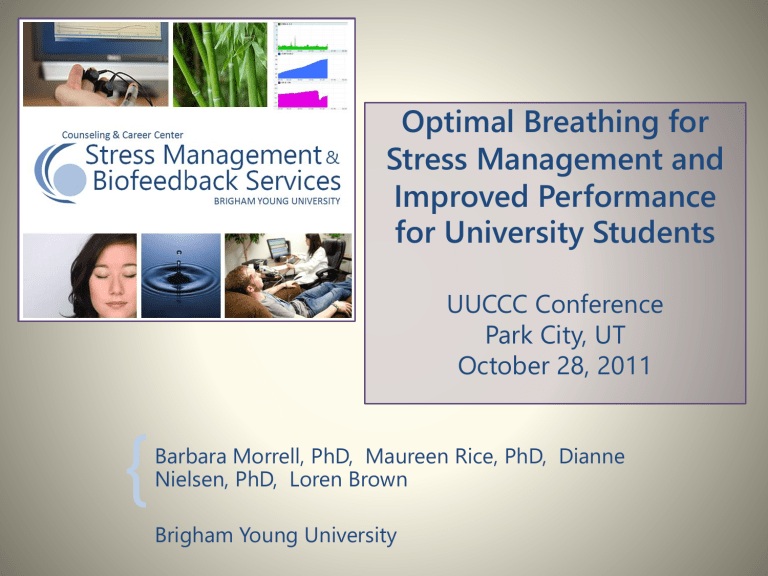
Optimal Breathing for
Stress Management and
Improved Performance for University Students
UUCCC Conference
Park City, UT
October 28, 2011
{
Barbara Morrell, PhD, Maureen Rice, PhD, Dianne
Nielsen, PhD, Loren Brown
Brigham Young University
Heart Rate Variability Biofeedback
• Cutting edge of biofeedback
– Interactive Programs: Need less guidance to use
– Less training of counselors to use effectively
• HRV Interactive BiofeedbackPrograms:
– emWave Destop: Heart Math--Optimal Breathing
– Dual Drive: runs on emWave or Relaxing Rhythms
– Relaxing Rhythms:
Wild Divine
Our Stress Response and
Relaxation Response
• Stress Management is like learning to drive.
• Our Stress Response, the Sympathetic branch
(SNS) of the Autonomic Nervous System (ANS), is like a gas pedal revving up our mind & body in reaction to physical danger or stress
• Our Relaxation Response, the Parasympathetic
Nervous System (PSNS), is like a brake which calms us down when we’re speeding out of control from stress
Activating our Relaxation Response
• Our gas pedal is automatic, often going from 0 to 60 in an instant in response to stress.
• Stress Management involves
– Training ourselves to put on the brake
(PSNS), as needed, just as in driving a car
– Deep relaxation/meditation: Bringing the car to a stop
– “Tapping” the brake proactively or in response to stress throughout the day
Breathing as a Brake
• For each of us there is an optimal number of breaths per minute (BPM) between
4.5 and 7 BPM which creates Autonomic Balance by synchronizing our Sympathetic
Nervous System (gas pedal) and Parasympathetic Nervous System (brake)
• Autonomic Balance helps us calm down, achieve optimal performance, and health
• We can use the emWave Desktop biofeedback program to estimate our individual Optimal BPM
• Practicing Optimal Breathing can
– Help us learn to brake on demand (activate the relaxation response)
– Over time increase Heart Rate Variability (HRV)
Heart Rate Variability (HRV)
• Beat to beat changes in Heart Rate (HR)
– HR should speed up on inhalation and slow down on exhalation
• HRV is decreased by shallow, fast breathing and negative thoughts and emotions (disordered and irregular rhythm)
• HRV training increases Vagal tone and the Baroreflex, which are involved in the ability of the heart to respond to stress
Why Emphasize Heart Rate Variability and
Optimal Breathing?
• Greater impact on heart health and wellness than relaxation alone
• HRV and Health
– High HRV= heart health
– Low HRV = greatest predictor of mortality
– Also associated with SIDS in infants
emWave Desktop
• Can be used with EZ-Air
Breath Pacer to determine Optimal BPM
• Techniques to help create an optimal state in which the heart, mind and emotions are operating in-sync and balanced
.
• Games (quite juvenile)
Dual Drive: Versions to run with emWave or Relaxing Rhythms
• Challenging racing or simple non-game graph training.
• Fun off-road racing. Drive
7cars through 9 detailed racetracks.
• Power your engine, clear the dark fog and win by relaxing and feeling good.
Relaxing Rhythms:
Formerly Wild Divine
• Uses HRV and GSR biofeedback
• A multi-dimensional approach that includes o Guided breathing and meditation exercises o Games you win by being in meditative state
EZ-Air Breath Pacer
• Free for 30 Days
• $20 for two computers
Optimal Breathing Resources
• Optimal BPM Breath-Sync music cd: http://breath-sync.com/products.html
– Inhale as notes go higher and exhale as they go (or vice versa).
– You can add pauses by stopping before it reaches the highest or lowest note.
• EZ-air computer breath pacer: Free for 30 days (no payment information up front)
– http://www.bfe.org/ez.htm
– Set the exhalation longer than the inhalation, for optimum benefit
• Smart phone apps:
– Android Free app http://www.freeware4android.net/healthcare-sport-medicine-tag/breath-pacer-litedownload-12906.html
– iPhone Free app http://iphoneappsplus.com/healthcare---fitness/mycalmbeat/index.htm
• Breathe to the clock or metronome:
– 6.0 BPM: inhale on even numbers, exhale on odd numbers
Coming Soon to our Website: http://ccc.byu.edu/cc/stress-management-lab
Handout Designs
Easy to read tabs and text boxes help students learn more about relaxation techniques.
Links to other websites, podcasts, and YouTube videos offer additional information.
8 Relaxation Techniques
Additional Stress
Management Skills / Tips
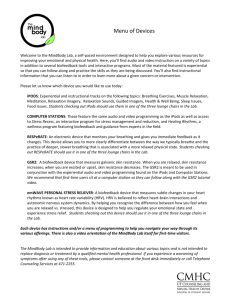
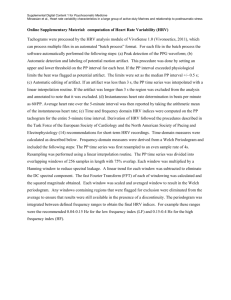
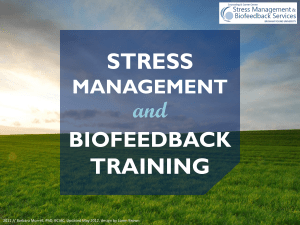
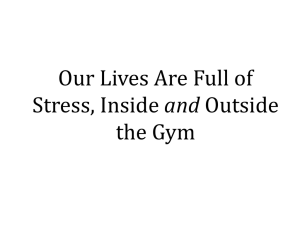
![Powerpoint Slide Set [, 6mb]](http://s2.studylib.net/store/data/005481140_1-14d8ec4dc37c7467f94ebd1212815b7e-300x300.png)
